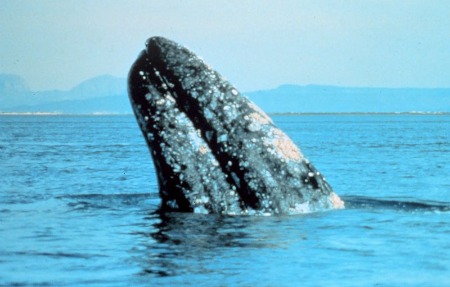Gray Whale Recovery Fuels Whalewatching Success


The pregnant females leave first, setting out from the winter breeding grounds of Mexico’s Baja California on the long journey north to Arctic waters off Alaska and Siberia. During the process the nautical families treat viewers along the west coast of the United States and Canada to one of the great sights of the natural world: the annual migration of the eastern Pacific gray whales.
For those pregnant whales, this year’s migration has been underway for about two weeks. For the whales that bring up the rear – mothers with calves – it will be perhaps another month yet until the young whales are ready to begin the journey. In between, in order, come non-pregnant females without calves, adult males, and then immature whales; all of them will swim up to 10,000 km (6,200 miles) to the north and then, after a summer of gorging in the Arctic, will cover a similar distance on the return voyage.
PHOTOS: World’s Best Marine Reserve: Cabo Pulmo
A little more than a hundred years ago, the prospect of this great migration continuing on any significant scale seemed remote. Gray whales had been extirpated from the Atlantic no later than the 18th century and perhaps some time before, and persistent shore whaling threatened to do the same in the Pacific. Whaling captain Charles Scammon predicted in 1874 that “it may be questioned whether this mammal will not be numbered among the extinct species of the Pacific.”
By 1900, grays had become so rare that some wondered whether Scammon’s prediction had come to fruition; whaling stopped for a while, but resumed again between 1925 and 1929 and then again from 1933 to 1946 until the gray whale was protected from commercial whaling with the signing of the International Convention for the Regulation of Whaling (although it was later revealed that Soviet whalers illegally took grays from 1961 to 1979).
Further protections were added with the U.S. Marine Mammal Protection Act of 1972 and listing under the Endangered Species Act of 1973; as a consequence, the population grew. Although the western North Pacific population is critically low, the eastern Pacific population is estimated to number somewhere around 22,000.
By using whalers’ logbooks to calculate how many whales had been hunted, scientists initially calculated that this figure was approximately the same as, and possibly in excess of, the pre-exploitation number; however, a 2007 study, based on DNA variation among gray whales, suggested that the original population had been in the vicinity of 96,000 whales and that therefore the population should still be regarded as depleted.
Get the world’s most fascinating discoveries delivered straight to your inbox.
PHOTOS: Nature’s Blockbuster Identity Thieves
The authors of that study do caution, however, that this figure could refer to the entire Pacific population, including the almost-vanished western Pacific grays, and almost certainly reflects a time when the Pacific coastal marine ecosystem was very different to today’s. Indeed, when several hundred emaciated dead gray whales washed ashore in 1999 and 2000, many scientists suggested it was a sign the population had rebounded so well that it was now at its ‘carrying capacity’ – the ability of the ecosystem to support it.
Concerns remain for the future: not from whaling, but from changes in the Arctic, as melting sea ice and warmer water alter the benthic ecology of the region to the potential detriment of the bottom-feeding grays. For now, however, grays are flourishing and the whalewatching business alongside it, as tourists flock to see them in the calving lagoons of Baja California and on their journeys northward and southward.
As naturalist Alisa Shulman-Janiger told NBC News recently, “These are the only whales to be taken off the endangered species list. So that’s a real success story.”
This story was provided by Discovery News.


